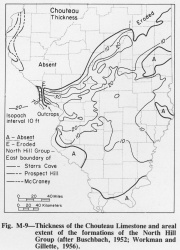McCraney Limestone
Lithostratigraphy: Mammoth Cave Limestone Megagroup >>North Hill Group >>McCraney Limestone
Chronostratigraphy: Paleozoic Erathem >>Mississippian Subsystem >>Kinderhookian Series
Allostratigraphy: Kaskaskia Sequence
Primary source
Willman, H. B., Elwood Atherton, T. C. Buschbach, Charles Collinson, John C. Frye, M. E. Hopkins, Jerry A. Lineback, and Jack A. Simon, 1975, Handbook of Illinois Stratigraphy: Illinois State Geological Survey Bulletin 95, 261 p.
Contributing author(s)
Elwood Atherton, Charles Collinson, and Jerry A. Lineback
Name
Original description
McCraney Limestone (Moore, 1928, p. 20).
Derivation
Named for McCraney Creek (misspelled McKerney in the original publication), near which the limestone crops out in the Mississippi River bluffs north of Kinderhook, northwestern Pike County.
Other names
History/background
It was originally designated a member of the Hannibal Formation, but Workman and Gillette (1956) made it the basal formation in the North Hill Group.
Type section
Type location
Type author(s)
Type status
Reference section
Reference location
Reference author(s)
Reference status
Stratigraphic relationships
The McCraney is conformable with the underlying Hannibal and the overlying Prospect Hill, but where the latter is absent the McCraney is unconformably overlain, and in places completely truncated, by the Burlington Limestone.
Extent and thickness
The McCraney occurs only in extreme western Illinois (fig. M-9). It has a maximum thickness of 58 feet near the Mississippi River but thins eastward, and within 15-20 miles it is entirely absent. It is well exposed along Fall Creek, southern Adams County (SE 23, 3S-8W).
Lithology
The McCraney Limestone consists of alternating thin layers of light gray to buff lithographic limestone with buff to brown, very fine-grained dolomite. A bed of coarsely oolitic limestone forms the top of the McCraney where the formation is thick.
Core(s)
Photograph(s)
Contacts
Well log characteristics
Fossils
Age and correlation
The conodont fauna shows that the McCraney correlates with the lower part of the Chouteau and the upper part of the Hannibal (Collinson, 1961; Scott and Collinson, 1961).
Environments of deposition
Economic importance
Remarks
References
COLLINSON, CHARLES, 1961, Kinderhookian Series in the Mississippi Valley, in Northeastern Missouri and west-central Illinois: Kansas Geological Society Guidebook, 26th Annual Field Conference, Missouri Geological Survey Report of Investigations 27, p. 100-109; Illinois State Geological Survey Reprint 1961-U.
MOORE, R. C., 1928, Early Mississippian formations in Missouri: Missouri Bureau of Geology and Mines, v. 21, 283 p.
SCOTT, A. J., and CHARLES COLLINSON, 1961, Conodont faunas from the Louisiana and McCraney Formations of Illinois, Iowa, and Missouri, in Kansas Geological Society Guidebook, 26th Field Conference, northeastern Missouri and west central Illinois: Missouri Geological Survey Report of Investigations 27, p. 110-141; Illinois State Geological Survey Reprint 1961-V.
WORKMAN, L. E., and TRACEY GILLETTE, 1956, Subsurface stratigraphy of the Kinderhook Series in Illinois: Illinois State Geological Survey Report of Investigations 189, 46 p.
ISGS Codes
| Stratigraphic Code | Geo Unit Designation |
|---|---|
